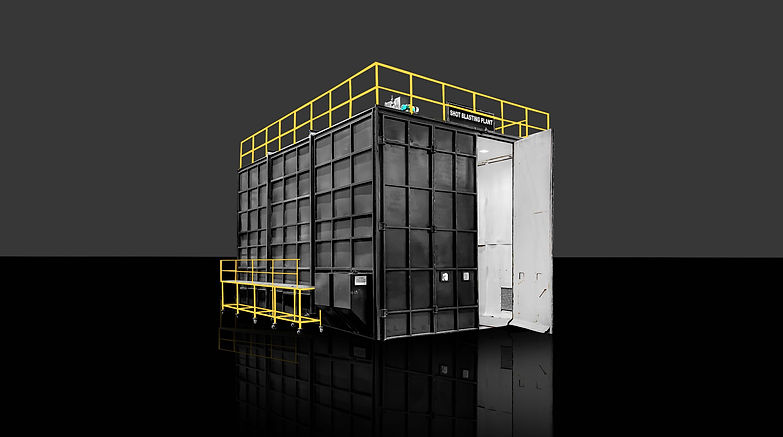
Blast Room Single Screw
Recovery System
Introducing our efficient and cost-effective Single Screw Recovery Blast Room System, designed for maximum productivity and minimal downtime. Trust us to take your blasting operations to the next level.

Single Screw Recovery Blast Room System
A single screw recovery blast room system is a specialized setup designed for efficient abrasive blasting operations. This system typically consists of a blast room enclosure where abrasive materials are propelled onto a surface to remove contaminants or coatings.
The single screw recovery mechanism utilizes a single screw conveyor system to collect and recycle the abrasive media after it has been used, reducing waste and minimizing the need for manual handling of abrasive materials.
This configuration streamlines the blasting process, improving productivity and ensuring a more sustainable approach to surface preparation and finishing applications. Additionally, the containment provided by the blast room enclosure enhances safety by confining the blasting operation and preventing the dispersion of hazardous materials into the surrounding environment.
Overall, the single screw recovery blast room system offers an effective solution for industries requiring precision surface treatment while prioritizing efficiency and environmental responsibility.
Blast Room System
Application:
Technology:
Standard/
Customization
Single screw recovery blast room systems are ideal for small to medium-sized operations requiring efficient abrasive media recovery and cleaning capabilities, commonly used in industries such as automotive refinishing, metal fabrication, and aerospace maintenance.
Recovery System
Customised option is available as per requirement
Delivery:
4 to 6 weeks
Features:
-
Blast Chamber: This is the primary area where blasting operations take place. It's typically a fully enclosed space where the workpiece is subjected to abrasive blasting to remove contaminants, rust, or coatings.
-
Screw Recovery System: The single screw recovery system is a central component of the setup. It's responsible for collecting used abrasive media and debris from the blast chamber floor and transporting it to the media recycling system for cleaning and reuse.
-
Media Recycling System: Once collected by the screw recovery system, the abrasive media and debris are typically processed through a media recycling system. This system typically includes components such as a cyclone separator, air wash separator, and media cleaning system to remove contaminants and debris from the media, allowing it to be reused in subsequent blasting cycles.
-
Dust Collection System: Blasting operations generate a significant amount of dust and debris, which must be efficiently captured and removed from the air to maintain a safe working environment and comply with environmental regulations. A dust collection system, typically consisting of dust collectors and filters, is employed to achieve this.
-
Control Panel: A centralized control panel allows operators to monitor and adjust various parameters of the blast room system, such as blast pressure, media flow rate, and dust collection settings. It may also include safety features and emergency stop controls.
-
Lighting and Ventilation: Adequate lighting and ventilation are essential for ensuring visibility and maintaining a comfortable and safe working environment inside the blast chamber. Proper ventilation helps remove dust and fumes generated during blasting operations.
-
Workpiece Handling Equipment: Depending on the specific application, the blast room system may include equipment for handling and manipulating the workpieces being blasted, such as overhead cranes, conveyors, or turntables.
-
Safety Features: Safety features such as interlocks, warning signs, emergency stop buttons, and personal protective equipment (PPE) are critical components of any blast room system to ensure the safety of operators and personnel working in the vicinity.
Material Compatibility:
-
Single screw recovery blast room systems are commonly used for abrasive blasting processes in various industries.
-
Material compatibility is crucial to ensure effective and safe operation of the system.
-
Typical materials compatible with single screw recovery blast rooms include steel, iron, aluminum, and other metals.
-
Non-metallic materials like glass, ceramics, and certain plastics may also be compatible, depending on the blasting media and process parameters.
-
Compatibility considerations include the material's resistance to abrasion, impact, and corrosion from the blasting media.
-
It's essential to consult with the blast equipment manufacturer and material suppliers to ensure compatibility and prevent damage to the system and workpieces.
-
Regular maintenance and inspection help in identifying any compatibility issues early on and ensuring the system's longevity and performance.
Compliance & Standards:
-
OSHA Compliance:
-
Adhere to OSHA regulations for worker safety.
-
Ensure proper ventilation and respiratory protection.
-
-
NFPA Standards:
-
Follow NFPA 654 for fire prevention and suppression.
-
-
EPA Regulations:
-
Comply with EPA rules on air emissions and waste management.
-
-
ANSI Guidelines:
-
Consider ANSI standards for equipment and eye protection.
-
-
Manufacturer Specifications:
-
Follow manufacturer instructions for installation and maintenance.
-
-
Quality Management Systems:
-
Implement a quality management system for consistent performance.
-
-
Industry Best Practices:
-
Incorporate best practices for efficiency and safety.
-
-
Training and Education:
-
Provide comprehensive training for operators and personnel.
-
